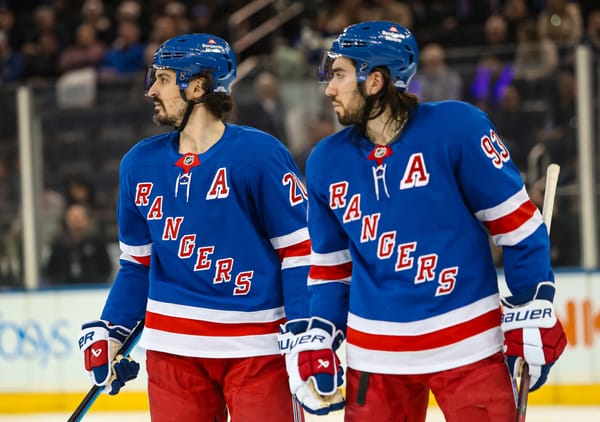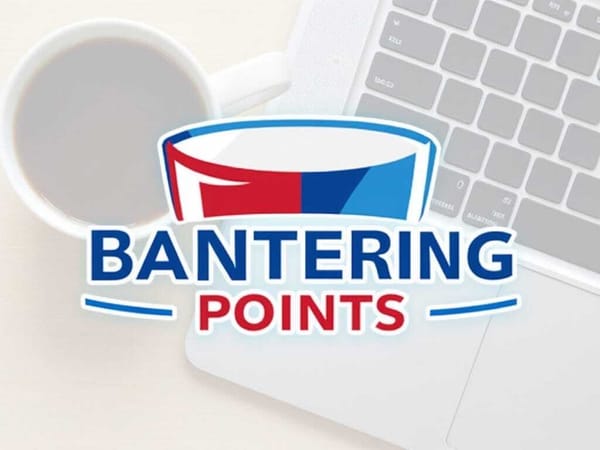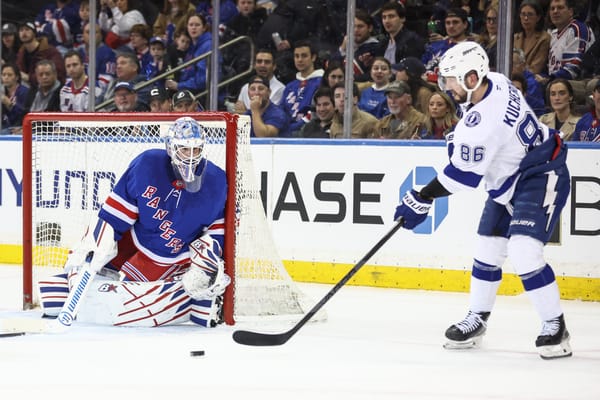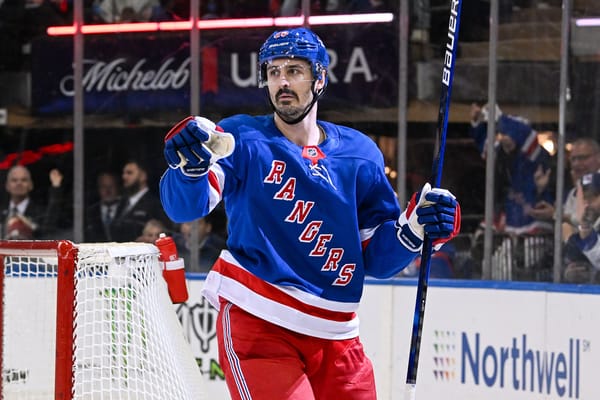On Hitting, or a Lack Thereof
Hitting doesn't correlate to winning. Therefore, neither does Tanner Glass. Regardless of what you think about the death of big body checks, everyone needs to get over it and recognize what can make this New York Rangers club a truly tough team to play against.
I have heard the same three refrains so far this season from enough casual and not-so-casual fans, and enough beat writers, to warrant a bit of a rant [edit: ok, a 3,000+ word rant]. Those three refrains are basically as follows:
1. The teams that can play physically are winning the Cups.
2. My team doesn't hit enough, they need to add more [grit/sandpaper/jam/truculence] to win against these tough teams!
3. Gary Bettman is killing the big body check, and it makes the game boring.
I hate every one of them because they are wrong and stupid. Sorry to be blunt about it. But you need to stop it. Right now. And if you are in that shrinking camp of folks who think that having a player like Tanner Glass in the lineup to help boost the Rangers hit and #grit quotient, and that doing so will ultimately help the team against "tough" opponents?
Well there is a a special place in hockey hell for you. Let me explain.
Physical Teams Are Winning All The Cups?
No they aren't. Only one team is doing that...that's the Los Angeles Kings. I'll explain why they hit a lot and do well in a bit. First, facts.
Stanley Cup Winner and NHL Total Hit Rank:
2014 - Los Angeles - 1st
2013 - Chicago - 30th
2012 - Los Angeles - 2nd
2011 - Boston - 21st
2010 - Chicago - 25th
2009 - Pittsburgh - 6th
2008 - Detroit - 11th
2007 - Anaheim - 10th
2006 - Carolina - 25th
2004 - Tampa Bay - 28th
2003 - New Jersey - 23rd
2002 - Detroit - 26th
2001 - Colorado - 8th
2000 - New Jersey - 16th
1999 - Dallas - 12th
1998 - Detroit - 2nd
That's as far back as I have NHL's Real-Time Scoring Statistics (RTSS) for. But it doesn't matter if I keep going. If you aren't just accepting that there is no correlation here, you are being really hardheaded. Wrongheaded. It's all over the map.
Back in 2013, Cam Charron, now working on analytics for the Maple Leafs, ran the RTSS stats to date for correlation to winning percentage. He wanted to see how road RTSS stats predict home wins, but the conclusion about hit correlation does not change. Before I show you his results, let me explain quickly and in simple terms how that is done, so nobody claims that it is sorcery not worth taking seriously.
An "r" coefficient measures the relationship between two variables. The two variables in this case would be the ability of the team (hits, takeaways, shots, shot attempts or Fenwick, wins...whatever) and points that the team gains. The resulting number can be between +1 and -1. A +1 shows a perfectly positive relationship. A -1 shows a perfectly negative relationship, and 0 indicates no relationship at all.
All you need to know is that an r between 0 and +0.09 basically indicates no correlation at all; an r between 0.1 and +0.3 indicates a small correlation; an r between 0.3 and +0.5 indicates a medium correlation; and an r between 0.5 and +1 indicates a large correlation. The same rules apply for negative numbers but moving to larger and larger correlations with less points gained, not more.
Here's what his numbers showed.
| Statistic | Ability/Points "r" |
| Fenwick Close | 0.218 |
| Wins | 0.199 |
| Goal Differential | 0.196 |
| Points | 0.177 |
| Goals | 0.084 |
| Giveaways | -0.002 |
| Takeaways | -0.003 |
| Hits | -0.021 |
| Blocked Shots | -0.117 |
| Goals Against | -0.119 |
Basically, hits are closer to a sign of a team that is losing points than gaining them. Steve Burtch over at Pension Plan Puppets had the following to say about the correlation, or lack thereof, between hits and winning in an excellent article he did in 2013 about the reliability of certain statistics, including repeatable "abilities" like hitting, in building a winner or a loser:
Virtually none of these matter to teams winning and losing. Teams win with an edge, or win without one. They also lose with an edge and lose without one. Being big and tough is NOT a cure all to a losing franchise... getting better at puck possession and spending more time in the other team's end is.
Why am I showing you these instead of running more numbers on it? Because nothing has changed this season. And nothing will. Hits are not suddenly a magical elixir for whatever ails a team. They will not lead to winning simply because the Kings hit more than anybody last year and won the Cup. Hockey has not changed so much that now, suddenly, hitting is MORE significant than it was in the past. A past that those lamenting over #grit and loud bangs are so passionate about returning to. A past where hitting did not lead to winning.
Here's this season's hit leaders and hit bottom feeders in a variety of common game states, ranked by hit% (percentage of hits in the game as compared to their opponent). I've also included their current points per game rank in parenthesis. Stats courtesy of puckon.net
Tied:
1. NYI - 60.5% (9th)
2. CBJ - 58.0% (29th)
3. BUF - 56.3% (30th)
28. CAR - 41.9% (28th)
29. MIN - 41.7% (14th)
30. CHI - 40.6% (15th)
Down 1
1. WPG - 63.6% (16th)
2. COL - 63.1% (25th)
3. DET - 62.7% (8th)
28. DAL - 44.2% (24th)
29. NYR - 44.0% (19th)
30. CHI - 33.9% (15th)
Down 2
1. WSH - 69.5% (23rd)
2. DET - 67.7% (8th)
3. CGY - 63.0% (10th)
28. MIN - 41.7% (14th)
29. NSH - 35.7% (6th)
30. CHI - 39.2% (15th)
Up 1
1. BUF - 60.3% (30th)
2. CGY - 55.7% (10th)
3. TB - 55.6% (4th)
28. MIN - 39.1% (14th)
29. MTL - 37.4% (2nd)
30. DET - 32.6% (8th)
Up 2
1. BUF - 63.2% (30th)
2. NYI - 55.6% (9th)
3. ANA - 53.9% (5th)
28. MIN - 35.4% (14th)
29. STL - 32.7% (3rd)
30. VAN - 31.7% (7th)
Notice anything? I mean other than that it's just a mish-mash of random teams at the top and the bottom for the most part? If anything, you see the worst team in the league by an unholy margin, the Buffalo Sabres, at the top of the hits list.
Being at the top or bottom doesn't even match up with those eye test perceptions that are haphazardly thrown around (often by mainstream media and even former players, who should know better). A team like, say, Chicago, who is often deemed "tough to play against" amongst other illusory terms, is at the bottom. Those gritty and defensively minded Wild? At the bottom.
That's why I'm not going to bother to run another r coefficient at you. I want casual fans, and hardheaded hardcore fans, to just see it in simple terms. Your team hitting more or less has no necessary correlation with winning.
Just to really hammer it home, here's last years total hits leaders and bottom feeders arbitrarily cut at top and bottom 5, with conference rank and finish in parenthesis:
1. Los Angeles (Stanley Cup)
2. Columbus (7th - 1st Rnd)
3. Toronto (12th)
4. Ottawa (11th)
5. Winnipeg (11th)
---
26. Detroit (8th - 1st Rnd)
27. Nashville (10th)
28. New Jersey (10th)
29. Minnesota (7th - 2nd Rnd)
30. Chicago (5th - Conf. Finals)
So please, just stop with the needing to hit to win. It's not the case.
2014-15 Score-Adjusted Corsi Leaders Aren't Really Big Hitters.
Ever on the analytics beat, I have latched onto a new formula for score-adjusted Corsi and its ability to be predictive of point totals, based on this article from puckon.net. Read it if you like math. If you don't, just understand that basically what it does is weight shot attempts based on game state. It uses total average team TOI in each state in order to do the weighting (more time at a particular game state means more weight). The resulting number has proven to be more correlated to predicting future success than anything else to date.
Your top score-adjusted Corsi teams to date, arbitrarily cut off at 10 teams, with their hits per 60 rank in parenthesis:
1. Chicago 57.1% (29th)
2. Pittsburgh 56.4% (10th)
3. Minnesota 55.9% (30th)
4. Detroit 54.0% (28th)
5. Boston 53.9% (13th)
6. St. Louis 53.6% (24th)
7. Tampa Bay 53.2% (19th)
8. Nashville 53.0% (25th)
9. San Jose 52.7% (17th)
10. Washington 52.6% (11th)
20. NY Rangers 49.5% (16th)
Sorry. I don't know what else to tell you on this.
Your Team Probably Does Not Need To Add More Hitting. They Need To Do Whatever They Should Be Doing In Their Chosen System, But Better.
There isn't one way to score more goals than your opposition. There isn't one way to do that more often than not, though there are some ways that work better in today's NHL than others. There isn't one way to win a Stanley Cup. Some hitting is system reinforced and a natural result of a particular system. Last year, the Rangers played a very physical team in the Stanley Cup Finals, and some saw it as a reason why they lost. The Kings are an example of a team that runs up hit totals because of their system, not necessarily just their personnel. And they executed their system well in the 2014 Stanley Cup Playoffs. It does not mean that a different system could not have countered and beat them.
Today's game is different. Not worse or less physical. Just different.
Most big hits in today's game do not come in open ice. That is not because the Department of Player Safety has cracked down on head shots. Head shots aren't a natural extension of open-ice hitting, or vice versa. Head shots are a player targeting another player's head or, possibly unintentionally, making initial contact with it. If you have played the sport or watched it even remotely closely, you know that it is much more effective to target the body, mainly at the midsection and hips where a player cannot shift or slide out of the way of the impact as easily.
The reason there are seemingly less open ice hits in the modern game are two-fold as I see it.
1) Players, quite simply, are WAY better at keeping their head up with the puck and while receiving the puck in the modern game. It is a lot harder to hit a target that is aware of your existence and acts accordingly. I don't care if you are an old-timer who yearns for simpler days. The game is faster now and the players are way better at it. If you sent Steven Stamkos back in time at his current speed and ability and knowledge of how to play it would be a damned circus.
2) The lack of a red-line in the modern game opens up neutral ice for greater extension of passing lanes, unclogging the middle of the ice a bit. We are all familiar with those big Scott Stevens open-ice explosions on unwitting players about to receive a pass in neutral ice. Put simply, because of (1) above, and because outlet passing can extend from the defensive zone all the way to the opposing blue line, defensemen can't risk going for the nuclear bomb open-ice hit and missing on it. They just can't.
Blame (2) on Bettman if you want. But if you would prefer neutral zone traps clogging up and minimizing rush opportunities, and you think that is less boring than the modern game, so be it. Once again, I cannot help you. But please, before you stop reading here, watch a low event team like the New Jersey Devils for a while and then reconsider. Really watch. Because their fans don't anymore. I don't blame them.
So about those Kings.
Big hits in today's game are leveled most often on the dump and chase forecheck. The combination of defensemen turning to play the puck, incoming forechecking forwards, and backchecking forwards behind them are a recipe for contact. The Los Angeles Kings love to dump and chase because they have the personnel to do it properly and the personnel buys into a swarming support system. In particular, a team like the Kings, who utilize an aggressive 2-1-2 forecheck on hard dumps, are going to hit a lot and retrieve resulting loose pucks. They are built for it. They are quick enough, and they have several big players. And those players have the puck retrieval anticipation and skill for it to work.
Credit: NHL.com
The New York Rangers are not a team that would necessarily benefit from this style of hockey.
While the Rangers have a nice mix of personnel, theirs is a game predicated on utilizing speed in transition to counter-attack with control for rush opportunities, or short chip and chases when they cannot gain the zone with control. They aren't all big and fast, though Chris Kreider and Rick Nash can play that game if tasked to. They aren't all smash and grab speedsters like Carl Hagelin.
They don't want the other team's defense to collapse on a loose puck, get set and fight for retrieval unless their speed is creating poor defensive gap control through neutral ice. That's where a chip and chase sometimes work well for them. Such as this:
Credit: NHL.com
The 2014-15 Rangers do not employ an aggressive 2-1-2 forecheck. Even in the play above, you saw Martin St. Louis deftly chip the puck in and chase it around the boards. It was met on the other side by a Ranger, who was reading and reacting to what was given, not going all out to the spot. Had the defense collapsed quicker and gotten there, he probably would have tried to squeeze the passing lane, not necessarily barrel in. That preferred style of play, reading and reacting to make forecheck decisions, has been an Alain Vigneault hallmark throughout his coaching career. It is a style that only relies on hitting when the second man in anticipates an opportunity to win the loose puck battle.
Rangers Hit Ranks:
Tied: 53.2% (8th)
Down 1: 44.0% (29th)
Down 2: 53.7% (15th)
Up 1: 43.8% (24th)
Up 2: 44.7% (18th)
This Rangers team does hit. But this is not the John Tortorella Rangers. Those teames worked a hard 2-1-2 forechecking style that was often reckless in approach and left the defense to deal with odd-man rushes going the other way. And it is generally a good thing that these Rangers don't play that style. Because, as we all know, the defense is suspect at best right now. Especially when being pressured on odd-man rushes coming back the other way.
Tanner Glass is 11th in the NHL in Hits per 60 minutes. So?
Among players with 50 minutes or more of TOI, Glass ranks 11th with 18.84 H/60. I can tell you right now, it isn't because he is generating offense with those hits. His Corsi For per 60 minutes is 43.48%. That is over 7% worse than noted defensive specialist, Dominic Moore. Meanwhile, Glass' Corsi Against per 60 rate is pretty unremarkable:
Despite his reputed abilities as a defensively sound player, Glass isn't really any better at suppressing shot attempts against than anyone else. He should be down there at the bottom of the graph with Dominic Moore. And the tradeoff for Glass' mediocrity in suppression is extremely reduced offense. Whereas Moore still is a positive play-driver towards the offensive zone.
So all that hitting by Glass is basically amounting to playing a lot in the defensive zone, and giving up a normal amount of shots while doing it. Neat. Should the Rangers send him out without a stick next game so he can focus on his best attribute? One that, as noted in the discussion of score-adjusted Corsi, doesn't help the team win?
If you have the puck, you generally don't hit as much. If you play a possession entry-driven style, as the Rangers are wont to do, you don't hit as much as in a dump and chase heavy system. Therefore, if you have, or want to have, the puck, a player like Tanner Glass, who decidedly does not have the puck, is a fish entirely out of water.Regardless of what role he is supposed to fill, or what deployment he gets (which to date, isn't all that DZS heavy). Hitting more, just for the sake of it, will not correlate to doing what the Rangers should be doing, better. In fact, it very likely means they are doing it worse when he is out there. Or in any game where you see them lighting up the hit count.
The reality is that, thanks to the hard work of Corey Sznajder and his Three Zone Project, we know that possessed carry-ins produce shot attempts at a rate of ~.58 per carry-in. By contrast, dump-ins only produce shot attempts at a rate of ~.26 per dump-in. The 2013-14 Rangers had a 49% rate of controlled carry-ins, which is just below the league-average of ~50%. That number is going up this season, and it should. This team is fast and prefers scoring off of rush opportunities coming from controlled zone entries. They should be focusing on that type of offense. I actually had a hard time finding many other types of goals. Here is their most efficient offense in a nutshell:
Credit: NHL.com
They get up ice as quickly as any team in the NHL and produce delightful rush chances. Rush chances are defined by David Johnson of hockeyanalysis.com as any shot attempt basically developed within 10 seconds from an event occurring in your defensive zone. Think odd man rushes, and a lot of controlled entry shots moving directly at the net or quickly laterally once in the zone. Generating those quick countering rush chances, which have the highest shooting percentage of any type of shot, is really tough to defend. I want to see more of them, and certainly hope that despite AV's strange deployment of Tanner Glass, he is telling the rest of the team to make this a priority.
Courtesy of: stats.hockeyanalysis.com
None of that, notably, requires more hitting.
No, they won't get intimidated by a team that hits more or is bigger than they are. Because they will have the puck and play with speed in their chosen system. No, it is not an inferior system. Nope. None of this requires more hitting. None of it requires whatever it is that Tanner Glass contributes. Could probably use an Anthony Duclair though.
No, hitting more won't help what ails the defense (a different article). It is more a matter of imposing their preferred style successfully than it is trying to play a differently constructed team's game, or one that relies on more checking.
What the Rangers need to do is own the puck more and spread the ice better in the neutral zone to facilitate more and faster carry-in pressure on opposing defenses. Because that is what they are built for, and that is what their systems are designed to promote. Executing that style can win games, because controlled entries are optimal for producing shot attempts. As you learned above, shot attempts (Corsi) correlates to winning. Not hits. Not banging. Not none of it.
So stop it.




